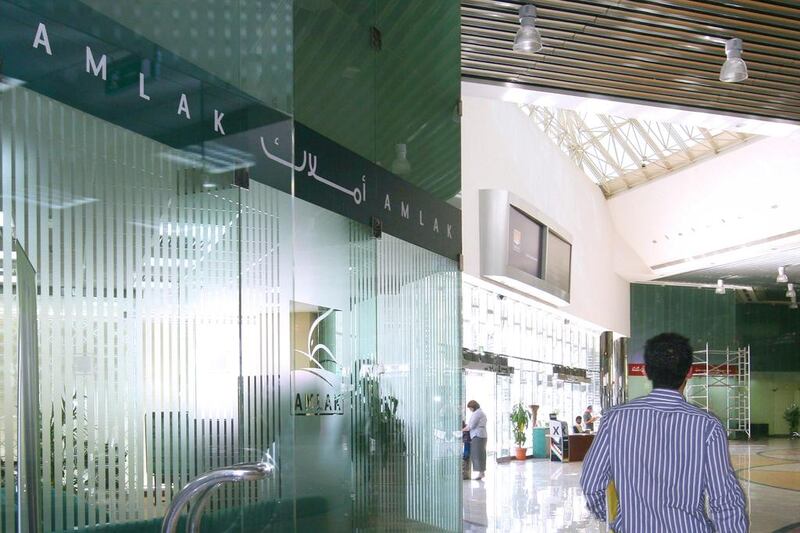Amlak, the Sharia-compliant mortgage lender that flirted with collapse when Dubai's property bubble burst, will resume share trading on the Dubai Financial Market today after a six-year hiatus.
Shares in Amlak were suspended in November 2008, after fears of a creditor exodus led the company to the brink of insolvency.
Shareholders have been locked into investments since trading was suspended – meaning today is the first time in six years they will be able to exit the company.
Amlak shares will reopen at Dh1.02 each – their closing price in 2008.
Statutory trading limits, which require the temporary suspension of shares that rise or decline by more than 15 per cent in a single day, will not apply to Amlak shares today, analysts said. Price limits will apply tomorrow and afterwards.
“It’s going to be a bloody day for the stock,” said Hisham Khairy, the head of institutional trading at Menacorp. “Investors have been waiting for this moment for six years. Everyone will want to sell. I don’t think institutions will wait a second before pressing the red button.”
There is an outside chance that some investors will want to support a prominently-named company, he added.
Tariq Qaqish, an asset manager at Al Mal Capital, also said that there would be a sell-off. “Investors were trapped,” he said.
Despite the bearish sentiment, Amlak said yesterday the company was ‘excited’ about its return to the market after having completed a “complex and comprehensive” restructuring.
“While we are aware of the challenges ahead, we now look forward to rebuilding our business quickly, focusing on our core real estate financing business, and delivering long-term value to our shareholders and customers,” it said.
Amlak faced collapse as the 2009 housing bust came close to wiping out the value of its property portfolio.
A mismatch between the short-term bank financing Amlak relied on, typically renewed on an annual basis, and its long-term mortgage liabilities left it vulnerable to short-term changes in banks' willingness to lend.
When the collapse of Lehman Brothers in September 2008 precipitated the biggest financial crisis in recent memory, Amlak’s creditors proved unwilling to roll over their funding arrangements with the lender. The subsequent 2009 collapse of property prices in Dubai, in which houses lost up to half of their value on average, meant that Amlak took a major hit to its portfolio of mortgage loans and properties.
The company said this month that it would have had a negative net asset position had it been forced to recognise the full size of its losses on its property portfolio on its balance sheet.
Fear that creditors would take flight as the lender’s balance sheet deteriorated led the UAE government to intervene. The Ministry of Finance and UAE Central Bank gave Amlak Dh1.7 billion to keep it afloat, which will be repaid over a six-year period from the end of last year.
A ministerial special committee was formed in February 2009 to explore ways to save Amlak and Tamweel, another distressed, Dubai-based mortgage lender. The committee laid plans to merge Tamweel and Amlak in a new entity to be bought by Abu Dhabi-owned Real Estate Bank.
But the merger never materialised. Instead, the government cut Amlak’s debt by US$1.1 billion, formed an ad hoc arbitration committee to handle legal claims against Amlak and arranged for negotiations between Amlak and an Emirates NBD-led consortium of 28 banks.
Amlak last year reached an agreement with creditors to repay its $2.7bn of debt over a twelve-year period.
Amlak’s net asset position has fallen slightly since the 2009 crash, after it booked multibillion dirham writedowns on its property portfolio. The company had net assets of Dh1.8bn at the end of the first quarter of this year, compared to Dh2.2bn in 2009.
Amlak took a Dh2.1bn impairment on its property portfolio last year as a prelude to an agreement with creditors.
“It remains to be seen whether [Amlak] will need to make further impairments” on the value of its asset portfolio, analysts at the National Bank of Abu Dhabi wrote.
But debt writedowns and a liquidity injection from the government mean that its liabilities have more than halved over the same period, falling to Dh5.5bn this year from Dh13.8bn at its peak.
Amlak holds 49 fils of equity per share. Emaar owns 45 per cent of the company’s outstanding shares.
Amlak has taken measures to pay down debt and has fired more than 60 per cent of its staff, the company said.
Analysts at the National Bank of Abu Dhabi said that Amlak might not be able to attract enough funding to “make sustainable net profit and generate meaningful returns on capital”.
The company’s brand image is another factor, according to Mr Qaqish.
“Reputation has to be rebuilt,” he said.
abouyamourn@thenational.ae
mkassem@thenational.ae
Follow The National's Business section on Twitter






